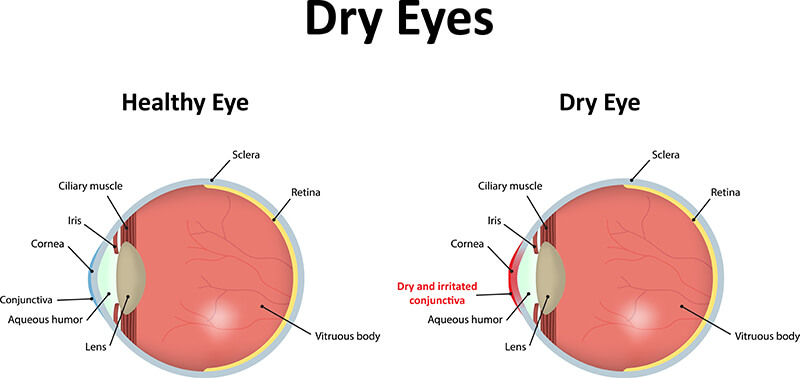Dry Eye Syndrome
What is dry eye syndrome?
Dry eye syndrome is a part of a very widespread set of conditions often grouped together as Ocular Surface Disease. This is in part because of the overlap in signs and symptoms caused by multiple eye conditions such as blepharitis and allergic conjunctivitis among other. Dry Eye Syndrome is an inflammatory condition that results as the amount of healthy tears on the surface of the eye is reduced. This can be from not making enough tears (aqueous deficiency) or if the consistency of the tears isn’t to the quality needed to maintain a healthy surface (evaporative). The aqueous deficiency type is usually a result of systemic disease such as diabetes, autoimmune disorders or thyroid dysfunction or as a side result of systemic disease such as diabetes, autoimmune disorders or thyroid dysfunction or as a side effect of various medications. The more prevalent type of Dry Eye Syndrome is the evaporative type. Here, the amount of tears made are often adequate. However, it’s the consistency of those tears that cause them to evaporate between blinks that causes problems. Patients often notice blurred vision coming and going thojughout the day and tearing/watery eyes. This condition is made worse by long periods of not blinking such as computer use, reading or eye straining while staring at electronic devices.

The aqueous deficiency type is usually a result of systemic disease such as diabetes, autoimmune disorders or thyroid dysfunction or as a side effect of various medication. The more prevalent type of of Dry Eye Syndrome is the evaporative type. Here, the amount of tears made are often adequate. However, it’s the consistency of those tears that cause them to evaporate between blinks that causes problems. Patients often notice blurred vision coming and going throughout the day and tearing/watery eyes. This condition is made worse by long periods on not blinking such as computer use, reading or eye straining while staring at electronic devices.
What are the types of dry eye syndrome?
Aqueous tear-deficient dry eye is a disorder in which the lacrimal glands fail to produce enough of the watery component of tears to maintain a healthy eye surface.
Evaporative dry eye may result from inflammation of the meibomian glands, also located in the eyelids. These glands make the lipid or oily part of tears that slows evaporation and keeps the tears stable.
Dry eye syndrome can be associated with:
- inflammation of the surface of the eye, the lacrimal gland, or the conjunctiva;
- any disease process that alters the components of the tears;
- an increase in the surface of the eye, as in thyroid disease when the eye protrudes forward;
- cosmetic surgery, if the eyelids are opened too widely;
- hormonal changes (more common in females);
- systemic medications such as blood pressure, antidepressants, birth control pills or hormone replacement therapy (HRT).


